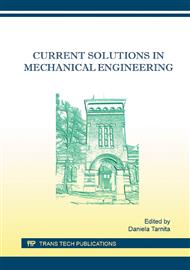[1]
J.M.T. Penrose, Development of an accurate three dimensional finite element knee mode, Comp. Meth. In Biomech. and Biomed. Eng. 5 (2002) 291-300.
Google Scholar
[2]
T. L H. Donahue et al, A finite element model of the human knee joint for the study of tibio-femoral contact. J. Biomech. Eng., 124(3) (2002) 273-280.
DOI: 10.1115/1.1470171
Google Scholar
[3]
D. Tarnita, M. Catana, D.N. Tarnita, Modelling and finite element analysis of the human knee joint affected by osteoarthritis, Key Engineering Materials, 601 (2014) 147-150.
DOI: 10.4028/www.scientific.net/kem.601.147
Google Scholar
[4]
D. Tarnita, M. Catana, D.N. Tarnita, Stresses and displacements for virtual models of healthy and osteoarthritic knee joint, Applied Mechanics & Materials, 658 (2014) 526-531.
DOI: 10.4028/www.scientific.net/amm.658.526
Google Scholar
[5]
D. Tarnita, M. Catana, D.N. Tarnita, Contributions on the modeling and simulation of the human knee joint with applications to the robotic structures, In New Trends on Medical and Service Robotics: Challenges and Solutions, Mechanisms and Machine Science, Springer, 20 (2014).
DOI: 10.1007/978-3-319-05431-5_19
Google Scholar
[6]
N.H. Yang, The effect of the frontal plane tibiofemoral angle on the contact stress and strain at the knee joint, Mechanical Engineering Dissertations Department of Mech. and Ind. Engineering, Northeastern University, (2009).
DOI: 10.17760/d10018955
Google Scholar
[7]
J.J. Liau, C.K. Cheng, C.H. Huang, W.H. Lo, The effect of malalignment on stresses in polyethylene component of total knee prostheses - a finite element analysis. Clin Biomech (Bristol, Avon) 17-2 (2002) 140–146.
DOI: 10.1016/s0268-0033(01)00109-7
Google Scholar
[8]
O. Harrysson, Y. Hosni, J. Nayfeh, Custom-designed orthopedic implants evaluated using finite element analysis of patient-specific computed tomography data: femoral-component case study. BMC Musculoskeletal Disorders, 8: 91 (2007).
DOI: 10.1186/1471-2474-8-91
Google Scholar
[9]
L. Zach, Ruzicka P., Konvickova S. and L. Cheze, Stress analysis of knee joint endoprosthesis. Journal of Biomechanics 40(S2) XXI ISB Congress, Poster Sessions, July, (2007).
DOI: 10.1016/s0021-9290(07)70563-8
Google Scholar
[10]
N. Chantarapanich, P. Nanakorn, B. Chernchujit, K. Sitthiseripratip, A finite element study of stress distributions in normal and osteoarthritic knee joints, J Med Assoc Thai, 92(6) (2009) S97-103.
Google Scholar
[11]
Information on http: /www. ansys. com.
Google Scholar


